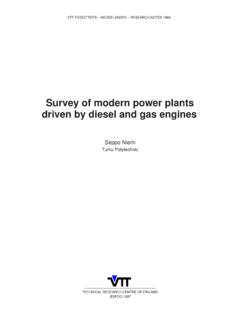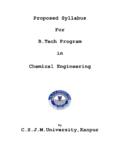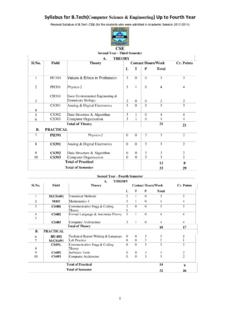Transcription of Design and selection of separation processes - vtt.fi
1 RESEARCH REPORTVTT-R-06143-15 Design and selection ofseparation processesAuthors:Lotta Sorsam ki, Marja NappaConfidentiality:PublicRESEARCH REPORT VTT-R-06143-151(68)Report s titleDesign and selection of separation processesCustomer, contact person, addressOrder referenceProject nameProject number/Short nameChemSep104341 Author(s)PagesLotta Sorsam ki, Marja Nappa68/KeywordsReport identification codeseparation processes , economic evaluation, equipment costestimation, modelling, BalasVTT-R-06143-15 SummaryProduct separation and purification is costly but crucial step in chemical production of information is needed in designing these systems, this is not however alwaysavailable for first conceptual Design .
2 The main focus in this project was on developingcompetence and readiness to conduct reliably but rapidly conceptual techno-economicassessments of (bio)chemical production processes . The idea was to develop a rapid methodand a generic short-cut model for evaluation of different alternative separation systemsmainly for solid-liquid and liquid-liquid systems, but also for gas-liquid and gas-solid model was created with Balas simulation software linked with MS Excel. Thedescription of the model is presented in PowerPoint slides,ChemSep report slides. Thisdocument, instead, acts as a theory source for the use of the model. In this document, theclassification of separation processes into heterogeneous and homogeneous separationprocesses is presented, different unit operations of separation are shortly described and thepossible application examples are listed.
3 Heterogeneous separation processes that aredescribed in detail include decantation, hydrocyclones, settling, sedimentation, flotation,centrifugal separation , filtration, wet scrubbers, leaching/washing and solid separation processes that are described in detail include flash vaporization,distillation, drying of solutions, evaporation, crystallization and membrane technology. Theoperational principles, equipment types, selection of appropriate equipment and applicationsfor each above mentioned separation process are described. The theory of the calculation ofmass and energy balance in each unit operation are excluded. It can easily be found in theliterature. Also, a short chapter of criteria affecting the selection of a suitable separationprocess for the mixture in question is skyl /Espoo byLotta Sorsam ki, Marja NappaResearch ScientistsReviewed byEemeli Hyt nenResearch Team LeaderAccepted byTuulamari HelajaHead of Research AreaVTT s contact Box 1000, 02044 VTT, FinlandDistribution (customer and VTT)VTTThe use of the name of VTT Technical Research Centre of Finland Ltd in advertising or publishing of a part of thisreport is only permissible with written authorisation from VTT Technical Research Centre of Finland REPORT VTT-R-06143-152(68)
4 PrefaceThis report has been written in the own founded projectChemSep - Rapid process designmethod for (bio)chemicals separation during autumn 2015. The main focus in this projectwas on developing competence and readiness to conduct reliably but rapidly conceptualtechno-economic assessments of novel biochemical production processes and waste watertreatment systems. The results of the project include; (i) a model created with Balas simulation software linked with MS Excel, (ii) this report, (iii) report slides containingdescription of the project and description and instructions of the model and also (iv) an MSExcel file where among the others data obtained from discussions with team members andfrom earlier models are collected.
5 This document, Design and selection of separationprocesses, acts as a theory source for the use of the model. In this document, theclassification of separation processes into heterogeneous and homogeneous separationprocesses is presented, different unit operation of separation are shortly described and thepossible application examples are listed. The document is written by Lotta Sorsam ki andMarja Nappa. Writers thank Eemeli Hyt nen who provided insight and expertise that greatlyassisted the research, and also the (team) colleagues from discussions and sharing theircompetence during skyl /Espoo Sorsam ki and Marja NappaRESEARCH REPORT VTT-R-06143-153(68)ContentsPreface .. 2 Contents.
6 separation techniques .. of heterogeneous mixtures .. separation .. drying .. of homogeneous fluid mixtures .. by phase addition or creation .. by barriers .. by solid agents .. by external field or gradient .. separation processes for homogeneous solutions .. vaporization and partial condensation .. of solutions, slurries and pastes .. the appropriate separation method .. conditions .. conditions, technological maturity and economics .. , thermodynamic and transport properties .. of of of separation processes with simulation softwares .. 62 References .. 67 RESEARCH REPORT VTT-R-06143-154(68)1. IntroductionProduct separation and purification is costly but crucial step in chemical production technologies for separating different liquid-phase (bio)chemical compounds from theirreaction media or waste water exist ( solvent extraction, crystallization, evaporation,distillation, membranes, phase separations, adsorption, chromatographic separation ).
7 Lots ofinformation is needed in designing these systems, this is not however always available forfirst conceptual report is a result from the projectChemSep - Rapid process Design method for(bio)chemicals separation . The main focus in this project was on developing competence andreadiness to conduct reliably but rapidly conceptual techno-economic assessments of novelbiochemical production processes and waste water treatment systems. The idea of this studywas to develop a rapid method and a generic short-cut model for evaluation of differentalternative separation systems mainly for solid-liquid and liquid-liquid systems, but also forgas-liquid and gas-solid systems. The created model will give technical specifications andeconomics of the systems for comparative and order-of-magnitude feasibility evaluations.
8 Itwill also guide the experimental research to measure critical parameters needed in designingthe product purification step. The method will give a systematic approach and enable fasterassessment with reliable ranking of separation alternatives already at early technologydevelopment model was created with Balas simulation software linked with MS Excel. The name ofthe model-file isChemSepModelTool. The description and instructions of the model arepresented in PowerPoint slides,ChemSep report slides. This document, instead, acts as atheory source for the use of the model. In this document, the classification of separationprocesses into heterogeneous and homogeneous separation processes is presented,different unit operation of separations are shortly described and the possible applicationexamples are separation methods are divided according the nature of the mixture to be treated.
9 Thereare two kinds of mixtures: heterogeneous and homogeneous. In heterogeneous mixtures,two or more phases mix, but remain physically separate. Heterogeneous mixtures caninclude mixtures consisting of (i) two liquids, (ii) a solid and a liquid, (iii) a liquid and a gas, oreven (iv) a gas and a solid. In a homogeneous mixture, the constituent phases areindistinguishable, having merged into a single uniform phase, with its original partsundetectable even at very high magnification. Solutions have only one phase and the mostcommon solutions are liquids, although there can be solutions of gases (air) and solids(alloys).In Chapter 3, separation technologies for heterogeneous mixtures are described.
10 Only thebasic principles of the process, equipment types and the selection of equipment are theory of solving the mass and energy balances or dimensioning the equipment isexcluded and can be found in literature. Good sources are for example Towler and Sinnott2013 and Seader et al. 2011. The separation of heterogeneous mixtures is accomplishedusing mechanical-physical forces including gravitational and centrifugal. Principal method forthe separation of heterogeneous liquid-liquid emulsions is decantation or hydrocyclones. Forgas-solid and gas-liquid separation ( gas cleaning), gravity settling, centrifugation, filtering,washing, and electrostatic precipitation may be used. The need to separate solid and liquidphases ( suspension) is probably the most common separation requirement in theprocess industries, and many techniques are used (sedimentation, centrifugation, filtration).












